Nestled in the heart of Vietnam, Cat Tien National Park emerges as a sanctuary of biodiversity, where lush landscapes and untamed wilderness converge to create a haven for wildlife enthusiasts. As a testament to the country’s rich primate diversity, Vietnam proudly shelters 24 species of these intelligent and charismatic creatures.
However, it is within the verdant embrace of Cat Tien National Park that a remarkable concentration of primates flourishes, showcasing a distinctive charm that sets this park apart. Home to an impressive 113 mammal species, Cat Tien National Park proudly hosts a remarkable population of primates, with a notable “7 Primate species in Cat Tien National Park” taking center stage. Join us on a journey into the heart of this ecological treasure, where the enchanting world of primates unfolds amid the breathtaking landscapes of Cat Tien.
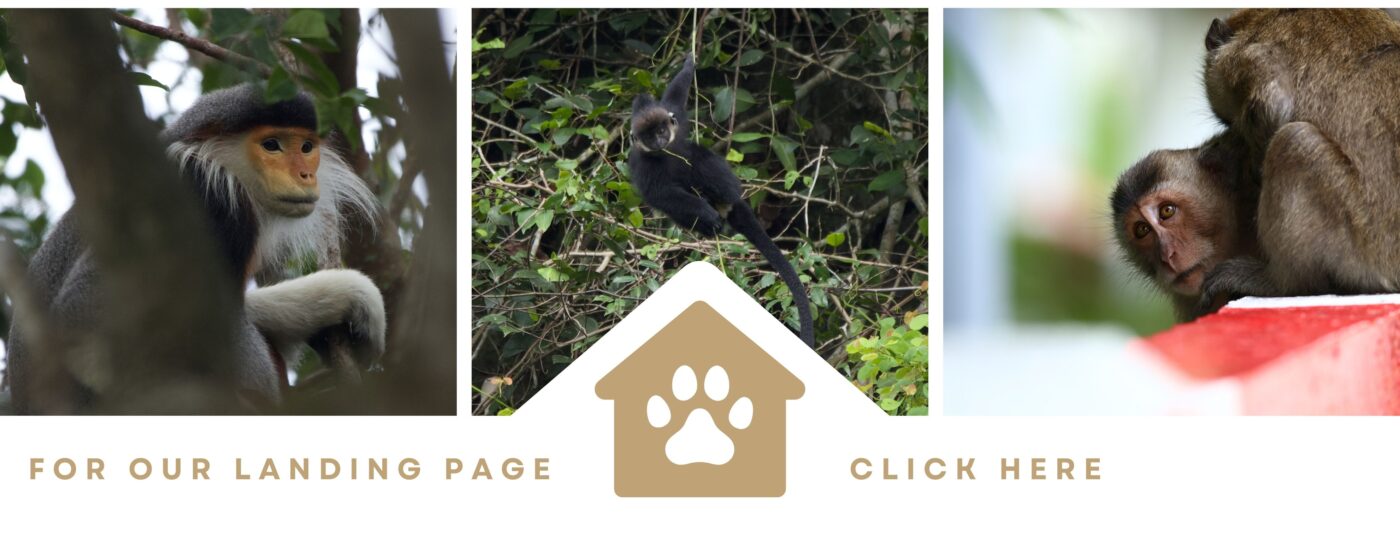
The Enigmatic Realm of Cat Tien National Park
Cat Tien National Park Overview: Cat Tien National Park is situated in southern Vietnam, around 150 kilometers north of Ho Chi Minh City. Encompassing an expansive area of approximately 720 square kilometers, the park boasts a rich tapestry of habitats, including Wetland and riparian areas, grassland expanses, tropical rainforest, dipterocarp forest, and semi-deciduous broadleaf forest. This diversity of ecosystems creates a unique and thriving environment that sets the stage for an unparalleled exploration of nature’s wonders. In the embrace of Cat Tien’s varied landscapes, visitors encounter the harmonious coexistence of diverse flora and fauna, making it a destination of immense ecological significance.
Exploring the 7 Primate Species in Cat Tien National Park: A Comprehensive Guide
Long-tailed Macaque (Macaca fascicularis):
Appearance: The Long-tailed Macaque exhibits sexual dimorphism, with males being notably larger than females. Adult individuals showcase a dark brown upper body with light golden brown tips. The underparts are light grey, and the tail is dark grey/brown. Their skin varies in color, with black on their feet and ears, and a light grayish-pink color on the muzzle. Distinctive features include backward-directed crown hairs, sometimes forming crests, and white markings on the eyelids. Males sport a mustache and cheek whiskers, while females have cheek whiskers only. The species possesses cheek pouches used for storing food while foraging.
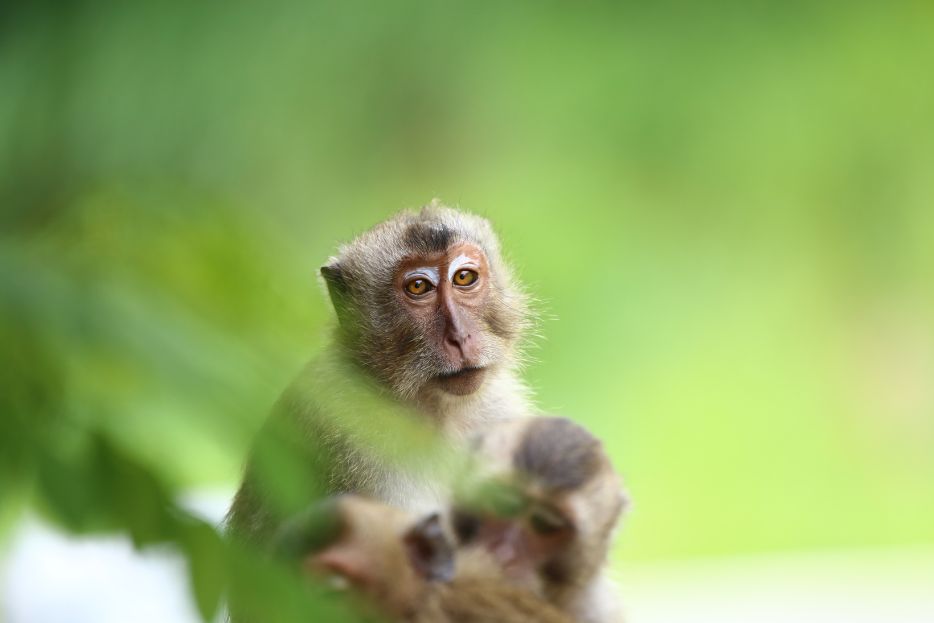
Habitat: Long-tailed Macaques are adaptable and can be found in various habitats within Cat Tien National Park. They are known to inhabit areas near human settlements, including the Headquarters of the park.
Behavior: These macaques are known for their proximity to humans, often begging for food. This behavior makes them one of the easiest primate species to encounter in the park, especially along the main routes.
Eating Habits: Long-tailed Macaques are omnivores and display a varied diet. They consume a wide range of items, including crabs, fruits, bread, and even leftovers from human activities.
Encounter Routes: Long-tailed Macaques are commonly encountered along the main routes of Cat Tien National Park. Their adaptability and interaction with humans make them a prominent species for observation.
Northern Pig-tailed Macaque (Macaca leonina)
Appearance: Northern pig-tailed macaques exhibit a distinctive appearance with a round greyish pelage extending from the sides of their cheeks around the top of their heads and beneath their chins, forming a crown-like pattern. A brown pelage patch is situated at the center of their crowns, followed by white triangular forms beneath this patch and along the top of their eyes. They feature one red stripe at each exterior corner of their eyes, angled upwards and diagonally meeting at the ending point of the white triangular eye extremities.
On their backs, especially in males, a black streak is present at the center, sometimes with a red hue towards the top and black towards the bottom. Their tails are thin, shorter, and skinnier than those of southern pig-tailed macaques. Adult males are characterized by defined shoulder musculature, and their tails are longer relative to females, with a darker contrast in their pelage.
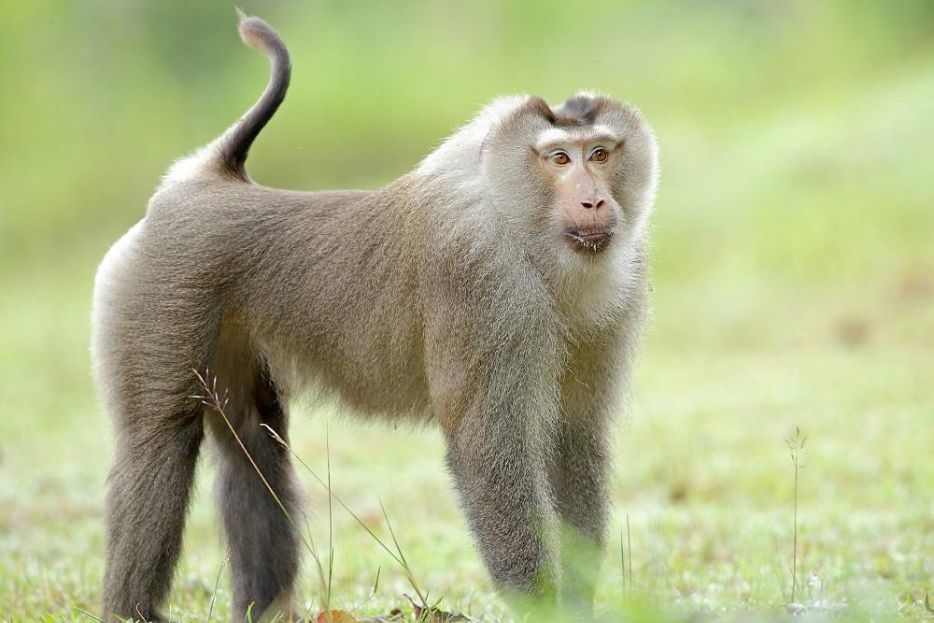
Habitat: Northern pig-tailed macaques primarily inhabit the edges of forests, similar to Long-tailed Macaques.
Behavior: These macaques are generally shy and tend to be more active during certain parts of the day. They may be found in groups, sometimes with Long-tailed Macaques or other primate species, but they also enjoy solitary moments.
Eating Habits: Similar to Long-tailed Macaques, they are omnivores, but they are more cautious and tend to avoid eating food from humans.
Encounter Routes: Northern pig-tailed macaques can be encountered in the Primate Rescue Centre, behind the headquarters, and sometimes in the vicinity of the Crocodile trail. Their elusive nature may require patience for a successful sighting.
Stump-tailed Macaque (Macaca arctoides):
Appearance: Stump-tailed macaques have long, thick, dark brown fur covering their body, except for the face and their short, almost invisible tail. Infants are born white and darken as they mature. As they age, their bright pink or red faces darken to brown or nearly black, and they lose most of their hair. Males are larger than females, with more elongated canine teeth, crucial for establishing dominance within social groups.
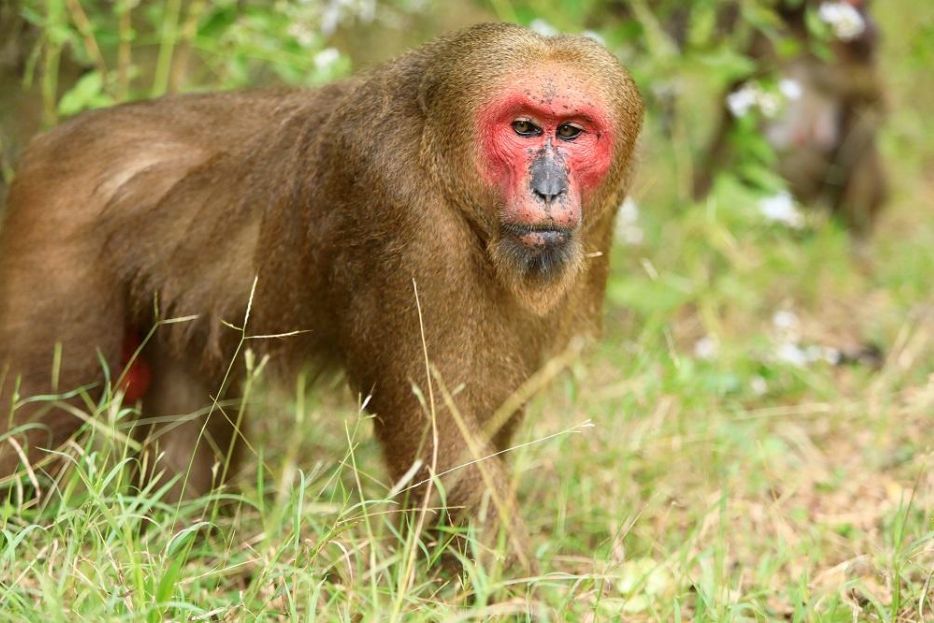
Habitat: These macaques prefer montane forests and hilly terrains as their habitat.
Behavior: Stump-tailed macaques are typically arboreal, showcasing skilled climbing abilities. They form multi-male, multi-female social groups, exhibiting social behaviors within their community
Eating Habits: Their diet consists of a variety of foods, including fruits, leaves, seeds, and insects. They also have cheek pouches and store food for short periods.
Pygmy Slow Loris (Xanthonycticebus pygmaeus):
Appearance: Distinguished by large eyes and a distinctive facial mask, the Pygmy Slow Loris exhibits captivating physical features. Adult specimens have a body length ranging from 19 to 23 cm (7.5 to 9.1 in) and a very short, almost invisible tail. Their fur is long, thick, and dark brown, except for the face. Infants are born white and gradually darken as they mature. Notably, males are larger than females, featuring more elongated canine teeth, crucial for establishing dominance within social groups.
Habitat: Thriving in a variety of forest habitats, Pygmy Slow Lorises are adapted to tropical dry forests, semi-evergreen, and evergreen forests. They are found east of the Mekong River, spanning regions in Vietnam, Laos, eastern Cambodia, and China.
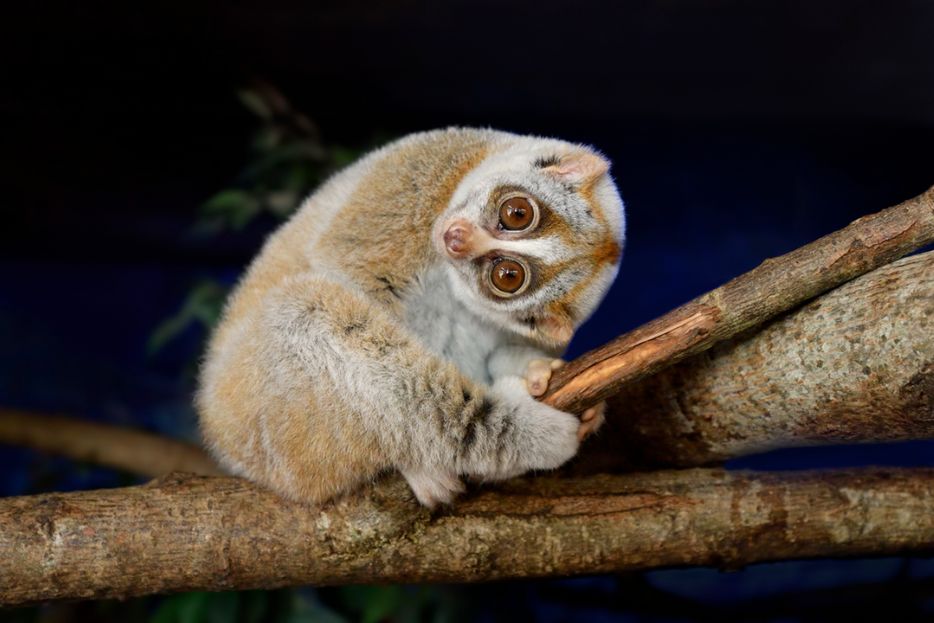
Behavior: Nocturnal and arboreal in nature, Pygmy Slow Lorises move deliberately and slowly along branches, showcasing skilled climbing abilities. Unlike some primates, they don’t rely on leaping. Typically, they form small groups, often with one or two offspring, displaying social behaviors within their community.
Eating Habits: Primarily insectivores, Pygmy Slow Lorises feed on insects and other small invertebrates. Their diverse diet also includes fruits, small fauna, tree sap, and floral nectar. Notably, they have cheek pouches and store food for short periods.
Encounter Route: For those seeking to encounter Pygmy Slow Lorises in Cat Tien National Park, specific locations and trails offer favorable opportunities: Surrounding the Main Trail: The area around the main tree serves as a potential hotspot, where patient observers may witness these primates navigating branches. Tung Tree Trail at Night: Nighttime exploration along the Tung Tree trail provides another chance to spot Pygmy Slow Lorises, as they are more active during darker hours. Lodge Area in the Northern Part of the Park: Occasional sightings near the Lodge in the northern region add an element of excitement to nighttime excursions.
Southern Yellow-cheeked Gibbon (Nomascus gabriellae):
Appearance: Gibbons are characterized by their slender bodies and long arms, with the Southern Yellow-cheeked Gibbon having distinctive yellow markings on its face. Born blond, the species undergoes a color change, with males maintaining golden cheeks throughout their lifespan. Females, initially blonde to blend into their mother’s fur, turn black and later revert to blond at sexual maturity, retaining a black cap on the top of their heads.
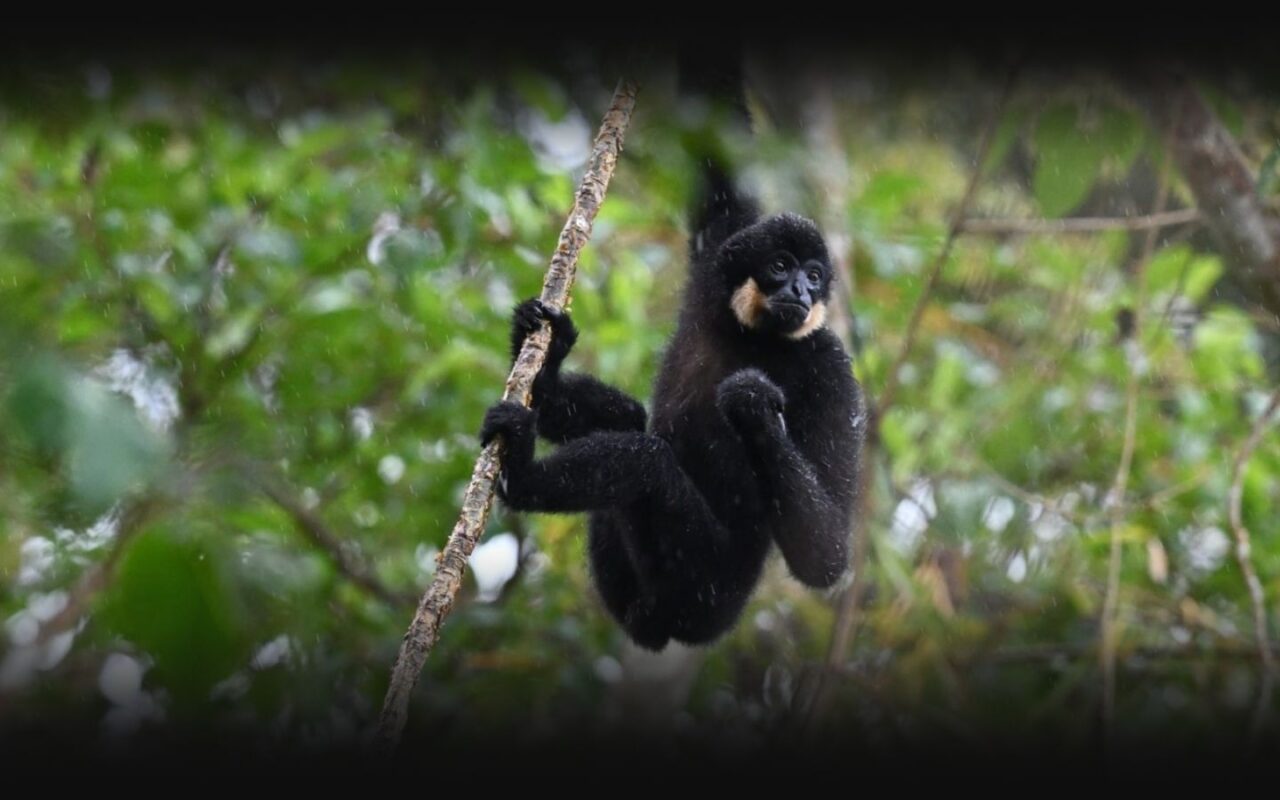
Habitat: Inhabiting tropical rainforests, the Southern Yellow-cheeked Gibbon is highly arboreal, utilizing primary tropical forests for foraging and movement through brachiation.
Behavior: Gibbons are known for their impressive swinging and brachiating abilities in trees. As diurnal and arboreal creatures, Southern Yellow-cheeked Gibbons navigate the forest canopy, utilizing brachiation to move efficiently through the trees. Gibbon groups vocalize loudly, particularly in the morning. These songs likely serve multiple purposes, including defending resources such as territories and food trees, as well as attracting potential mates through coordinated duetting between mated pairs.
Eating Habits: Their diet includes fruits, leaves, and occasionally small animals. Foraging for fruits in the tropical rainforest, these gibbons display agility and adaptability in their feeding habits.
Encounter Route: For a guaranteed sighting, visit the behind of the headquarters at Cat Tien National Park early in the morning. Here, Southern Yellow-cheeked Gibbons can be observed, often accompanied by friends who have been rescued by humans when injured. This area provides a unique opportunity to witness these arboreal creatures in a setting where they have found refuge and care.
Additional Information:
- The Southern Yellow-cheeked Gibbon, also known as the golden-cheeked gibbon, red-cheeked gibbon, or buffed-cheeked gibbon, is native to Vietnam, Laos, and Cambodia.
- Discovered and named after the British naturalist Gabrielle Maud Vassal, this species undergoes a notable color change from blond to black and later back to blond.
- The diurnal and arboreal nature of these gibbons is reflected in their brachiation, a mode of movement that allows them to swing and travel efficiently through the forest canopy.
- Little is known about this species in the wild, and it is estimated to have a lifespan of approximately 46 years.
Germain’s Langur (Trachypithecus germaini):
Appearance: Germain’s langur exhibits distinct black coloration on its hands, feet, upper body, and face, fading into paler grey on its underparts. Long grey tails and white hairs on their round faces distinguish them, while young langurs have bright orange fur.
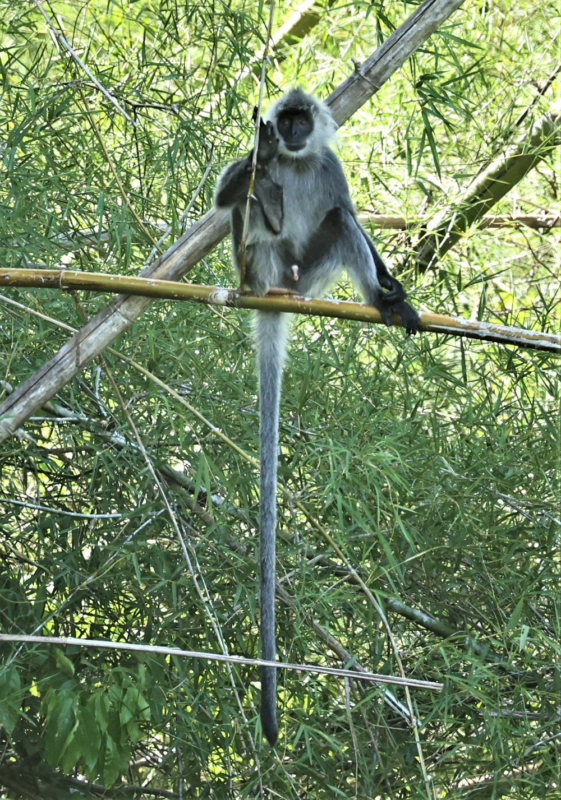
Habitat and Distribution: Found in Asia, specifically in Cambodia, Vietnam, Lao PDR, Myanmar, and Thailand, the distribution of Germain’s langur is not fully understood. Populations in Vietnam are severely reduced, with limited sightings, while Lao PDR shows multiple patches of higher relative abundance. In Cambodia, their distribution is widespread, with varying abundance from common to rare. In Thailand, the species is common, with many protected areas supporting large populations.
Behavior: Germain’s langur is primarily arboreal, living in social groups led by a dominant male. This terrestrial arboreal species is often found in lowlands and prefers evergreen, semi-evergreen, riverine, mixed deciduous, and gallery forests. They are not commonly found at high elevations or hilly areas.
Eating Habits: Their diet is folivorous, consisting of leaves, shoots, and fruits. This diet dictates a resting period, during which they undergo the process of rumination.
Encounter Route: While Germain’s langur is quite hard to encounter in the wild, there are specific locations where sightings are possible. Dao Tien Primate Rescue Centre and the Crocodile trail in Cat Tien National Park offer opportunities to observe these elusive langurs. Patience and a keen eye are essential, but the potential reward is witnessing Germain’s langur in their natural habitat.
Black-shanked Douc (Pygathrix nigripes):

Appearance:
- The black-shanked douc presents a striking and distinctive appearance, making it easily recognizable in the lush greenery of Cat Tien National Park. Characterized by its unique coloration, this douc species boasts a predominantly greyish-blue face, setting it apart from other doucs.
- Their bodies are adorned with a captivating mix of colors, featuring shades of grey and blue. The legs, or “shanks,” are notably black, creating a stark contrast against the lighter fur on the rest of their bodies.
- As with many primates, males and females exhibit sexual dimorphism. Males often have more pronounced features, emphasizing the species’ overall elegance and visual appeal.
- The black-shanked douc’s enchanting appearance adds a touch of rare beauty to the biodiversity of Cat Tien National Park, making any encounter with this endangered species a truly special and memorable experience.
Habitat: Black-shanked doucs prefer dense, undisturbed forests, showcasing a particular affinity for thriving in the treetops. They are skilled climbers, utilizing the forest canopy as their primary habitat.
Behavior: Living in large social groups, black-shanked doucs are known for their acrobatic movements in trees. Their arboreal lifestyle allows them to navigate the forest canopy with agility. Observing them in their natural habitat reveals the complex dynamics of their group interactions.
Eating Habits: Their diet includes a variety of leaves, fruits, and flowers. They are selective eaters, displaying preferences for specific plant species. Leaves, especially young leaves, constitute a significant part of their diet. Additionally, a study of the largest known population observed a high consumption of seeds, indicating dietary diversity.
Encounter Route: Encountering black-shanked doucs requires strategic observation points within Cat Tien National Park. Specific locations where sightings are possible include the behind of the bungalow, Ben Cu Rapid, Dao Tien Primate Rescue Centre, and the main trail. While encounters can be unpredictable, these areas offer glimpses into the daily life of this endangered douc species. Visitors may witness their remarkable behaviors, providing a deeper appreciation for the conservation efforts aimed at protecting their habitats.
Click here if you want more information about Cat Tien National Park
Conservation Efforts
Cat Tien National Park stands as a bastion of biodiversity, home to a diverse array of primate species, each facing unique challenges to their survival. Conservation initiatives play a crucial role in safeguarding these remarkable creatures and their habitats.
1. Gibbon Conservation:
- The Southern Yellow-cheeked Gibbon, with its distinctive yellow markings, is a flagship species in conservation efforts. Protecting their tropical rainforest habitat is paramount to ensuring their survival.
- Conservation projects focus on preserving large, contiguous forest areas to allow gibbons to roam freely. These projects also address the illegal pet trade, a significant threat to their population.
2. Langur and Douc Conservation:
- Germain’s Langur and Black-shanked Douc face habitat fragmentation and degradation due to human activities. Conservation initiatives aim to maintain and restore their preferred forest habitats.
- Protected areas within the park, like the Dao Tien Primate Rescue Centre, contribute significantly to the rehabilitation and release of confiscated or injured primates.
3. Macaque and Slow Loris Conservation:
- Long-tailed Macaques, Pig-tailed Macaques, and Pygmy Slow Lorises encounter threats such as habitat loss and illegal wildlife trade. Conservation efforts concentrate on combating these challenges.
- Awareness programs targeting local communities emphasize the importance of preserving these primates and their habitats. Rescue and rehabilitation centers play a pivotal role in caring for confiscated or injured individuals.
4. Douc and Loris Conservation:
- The Stump-tailed Macaque and Pygmy Slow Loris, residing in montane forests and tropical dry forests, confront habitat loss due to deforestation. Conservation endeavors aim to protect their diverse habitats.
- Sustainable forestry practices and community engagement initiatives contribute to maintaining suitable environments for these primates.
Conservation Initiatives:
- Protected Areas: Designation and maintenance of protected zones within the park, such as the Keo Seima Wildlife Sanctuary, contribute to primate conservation.
- Habitat Restoration: Efforts focus on restoring degraded habitats to provide viable living spaces for primates.
- Community Involvement: Engaging local communities fosters understanding and support for primate conservation, addressing challenges collaboratively.
Challenges:
- Habitat Loss: Expanding human activities and deforestation threaten the natural habitats of these primates.
- Illegal Wildlife Trade: The pet trade poses a significant threat, leading to the confiscation of primates that require rehabilitation.
- Human-Wildlife Conflict: Encroachment by human populations can result in conflicts, affecting primate populations.
Despite these challenges, ongoing conservation endeavors exemplify a commitment to preserving the diverse primate species within Cat Tien National Park. Through a combination of scientific research, community engagement, and protective measures, these initiatives strive to ensure the long-term survival of these enchanting creatures and the ecosystems they inhabit.
Visitor Experience
Guided Tours:
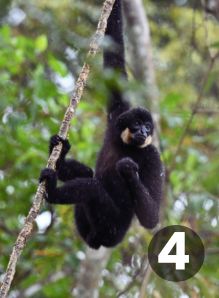
Immerse yourself in the beauty of Cat Tien with a specially crafted tour focused on primate watching. Knowledgeable guides lead you through strategic routes, enhancing the chances of encountering various primate species.
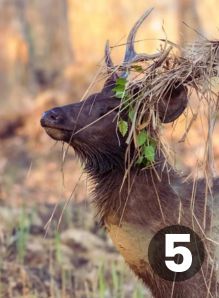
This comprehensive tour goes beyond primates, offering an exploration of the diverse wildlife within the park. Discover the rich biodiversity, including various primate species, during this extended wildlife-watching experience.
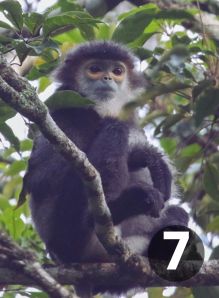
For photography enthusiasts, this tour combines the thrill of primate observation with the art of capturing these incredible moments. Learn to photograph primates in their natural behaviors with guidance from experienced professionals.
Click here for more photos of Wildlife: Facebook
Observation Points:
- Strategic Locations: The park’s knowledgeable guides lead visitors to carefully selected observation points, maximizing opportunities for primate sightings. These strategic locations often align with the habitats and behaviors of different primate species.
- Tree Platforms: Elevated tree platforms provide an unobtrusive vantage point for observing primates. Guides assist visitors in navigating these platforms, ensuring a safe and memorable primate-watching experience.
Special Experiences:
- Night Safaris: Venture into the park during the evening for a unique experience of nocturnal primates, such as the Pygmy Slow Loris. The park comes alive with sounds and movements, offering a different perspective on primate behavior.
- Primate Rehabilitation Center: Explore the Dao Tien Primate Rescue Centre, where rescued and rehabilitated primates find refuge. Witness the dedication of conservationists working towards the well-being of these incredible creatures.
Plan Your Primate Adventure:
- Visitor Center: Start your journey at the Visitor Center, where you can gather information about available tours, obtain permits, and learn about the best times for primate watching.
- Accommodations: Choose from a variety of accommodations, ranging from eco-friendly lodges to homestays. Enjoy the tranquility of staying within the park, enhancing your overall wildlife experience.
More Cat Tien Primate Tours at WANEE
Deep in Vietnam’s Cat Tien National Park, seven unique primate species thrive, from the playful Long-tailed Macaque to the elegant Southern Yellow-cheeked Gibbon. Each plays a vital role in the forest’s delicate balance. More than just a wildlife encounter, this journey is a call for conservation. As you watch these primates swing, forage, and interact, you’ll see why protecting their home is so important.
Across Vietnam, conservation efforts are expanding—from reforestation projects to wildlife rescue and habitat protection. At WANEE, we believe that the more we appreciate nature, the more we’ll want to protect it. That’s why our tours are designed to inspire a deeper love for wildlife and a stronger commitment to conservation. While trying harder every day to protect the balance of nature, our wildlife tours give tourists the chance to explore Vietnam’s natural beauty, understand how different habitats connect, and take action to protect them.
Scheduled Wildlife Tours
Tailored Wildlife Tours
Click here to see more tailored tour options
Visit our sites:
– Facebook: WANEE Vietnam (Wild and Nature Exploring)
– Instagram: WANEE Vietnam and WANEE Kids hub
Are you looking for Wildlife Tours in Vietnam?
WANEE VIETNAM is your go-to destination for "Wildlife Tours in Vietnam", specializing in Birding, Primate Watching, Herping, Photography Tours and Educational Tours led by our expert guides.Hot-spot for Birding in Vietnam
all birding in hot-spot informative info [updated Jan 2023]
Nr. Nature reserve; Np. National Park; mt. Mountain
How to Identify the Greater Sand Plover, Tibetan Sand Plover and Siberian Sand Plover
Identification Differences within the Sand Plover Complex: The sand plover group, which was traditionally divided [...]
Highlights of Cat Tien National Park Reptiles and Amphibian Endemics
Spanning over 71,350 hectares of tropical forests, grasslands, and wetlands, Cat Tien National Park is [...]
Highlights of Cat Tien National Park Mammals in a World Biosphere Reserve
In addition to reptiles and birds, Cat Tien National Park is also rich in mammals, [...]
Kontum Plateau Endemic and Highlight bird
Kontum Plateau Endemic And Highlight Bird species like Chestnut-eared Laughingthrush and top birding routes while [...]
Dalat Plateau Endemic and highlight bird
The Dalat Plateau is a birdwatcher’s paradise, renowned for its exceptional biodiversity and unique highland [...]
Cat Tien National Park Endemic and Highlighted Birds
Covering 71,920 hectares in southern Vietnam, Cat Tien National Park is home to a number [...]